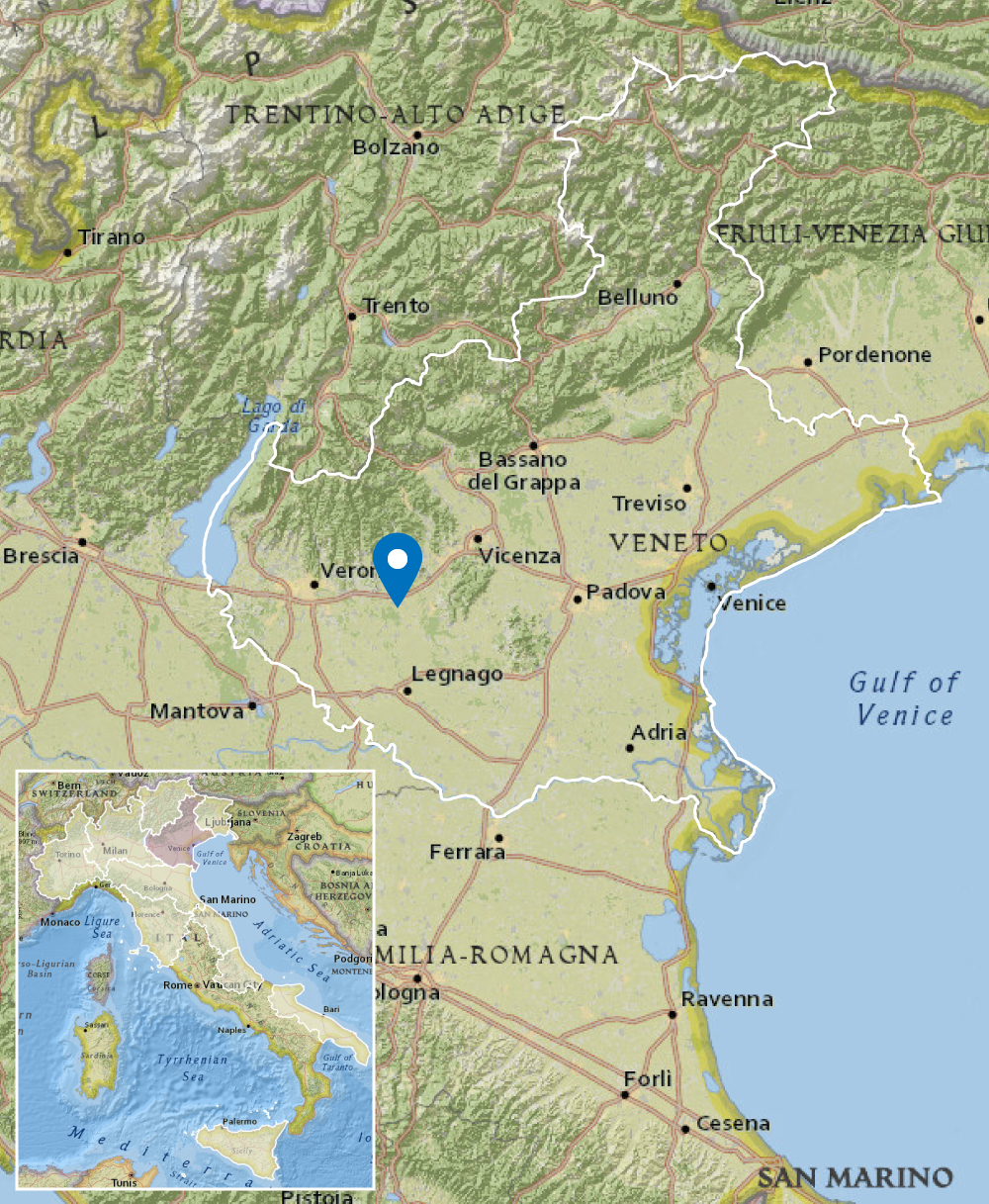| WINERY NAME: | INAMA |
| WINERY LOCATION: | San Bonifacio, Veneto |
| VINEYARD LOCATION: | Soave (Verona province) and Colli Berici (Vicenza province), Veneto |
| VINEYARD LAND: | 210 acres (85 ha) |
| FARMING PRACTICES: | DIVERSITY ARK® Certification |
| GRAPE VARIETIES: | Garganega and Carmenère; smaller amounts of Cabernet Sauvignon, Merlot, Chardonnay, and Sauvignon Blanc |
| WINE STYLES: | Dry white; dry red |
| WINE REGIONS: | VENETO |
| TOTAL WINE PRODUCTION: | 800,000 bottles (600,000 liters) |
| YEAR FOUNDED: | 1967 |
| OWNER(S): | Stefano Inama |
| WINEMAKER(S): | Stefano & Matteo Inama |
 |
The walled city of Soave in the Veneto region is the source (and namesake) of one of the great classic Italian white wines. The town dates from Roman times, and so does the winemaking tradition. The Romans were big fans of minerally, floral wines like those of Soave. The Garganega grapes, that for many centuries have produced Soave wines, come mainly from vineyards in the hills that rise behind the town and march northwestward toward the eastern Valpolicella. This area is now known as Soave Classico and is still the source of the best wines of the denomination due to the hills’ volcanic soils. Leaving Soave through the Porta Aquila—the north gate of the city’s 14th-century walls—a walk of a mile and a quarter (including a climb of about 500 feet) leads to the top of Mount Foscarino, a dormant volcano now covered with grapevines. In the 1960s, Giuseppe Inama began buying up small vineyard plots on this peak in the heart of the Soave Classico zone, and as a result, the Inama winery today owns most of the vineyards on Mount Foscarino. Giuseppe Inama saw the great potential of these old, traditional vineyards at a time when others were more intent on producing larger quantities in the plains for inexpensive exports. His son Stefano, who took over the winemaking duties in 1992, has continued to work tirelessly to realize the potential of these vineyards, working with some of the very best vineyard management consultants in the world to get Inama’s vineyards into the best possible shape. Near the top of the hill is a large wooden platform with a 270-degree panoramic view to the south and east. To the right at a distance, it is easy to spot the crenellated walls and towers of Soave Castle as it keeps watch over the town. In the foreground are Inama’s tidy vigneti di Foscarino (Foscarino vineyards). And to the left, over the vineyards and across a broad valley, are a set of hills that are the home of Inama’s other project. These hills—the Colli Berici—are composed of iron-rich terra rossa, a soil type that is prized worldwide as being ideal for growing red winegrapes, and indeed this is where Inama gets its red wines. In the mid-19th century, the Colli Berici (pronounce KOH-lee BEHR-ee-chee) area was settled by groups of Italians returning from southwest France, and some of them brought with them cuttings of Bordeaux grape varieties to plant in their new home. Thus, Colli Berici has more than 150 years of tradition growing Cabernet and Merlot, as well as Carmenère, which was an important ingredient in the Bordeaux blend back then (pre-phylloxera). When looking to expand the winery’s portfolio to include red wines, Stefano Inama saw great potential for these grape varieties in Colli Berici—especially the underrated Carmenère—and began investing in vineyards there. Today, Inama has about 70 acres of vineyards in the Berici Hills, including the largest plantings of Carmenère in Europe. Inama is one of those producers who embodies the respect for tradition but is constantly thinking and striving to do more and better and isn’t afraid to take risks. Stefano Inama spent a lot of time talking with long-time local growers about what Soave was like decades ago when it was one of the best-known whites in the world. From these discussions, he learned that Garganega seemed to respond well to some old-fashioned techniques such as longer skin contact and less sulfur usage. Accordingly, intervention during winemaking is now kept to a minimum. The grapes undergo a short maceration and gentle pressing, followed by a temperature-controlled fermentation, spontaneous malolactic fermentation, and ultimately bottling with a minimum of fining and filtration. The winery has also conducted a great deal of research into clonal selection and canopy management with the goal of maximizing fruit concentration while retaining varietal typicity. In 2020, the third generation of the Inama family joined the family winery and, today, brothers Alessio, Matteo and Luca are unapologetically pushing the winery to new heights - from their agricultural approach to their winemaking philosophies to new spirit of experimentation. In the final analysis, Inama has truly succeeded in combining ancient grape varieties, nearly forgotten winemaking practices, and modern technology to produce both white and red wines that are benchmarks for northeastern Italy. |
 |
WINES IN THE INAMA PORTFOLIO
· Inama “Vin Soave” Soave DOC Classico
· Inama “Foscarino” Soave DOC Classico · Inama "Carbonare" Soave DOC Classico · Inama "I Palchi" Foscarino Soave Classico DOC · Inama "Vintage Collection" Soave Classico DOC 2016 · Inama "Vulcaia Fumè" Sauvignon del Veneto IGT · Inama “Carmenère Più” Veneto Rosso IGT · Inama “Bradisismo” Colli Berici Cabernet DOC · Inama “Oratorio di San Lorenzo” Colli Berici DOC Carmenère Riserva |

